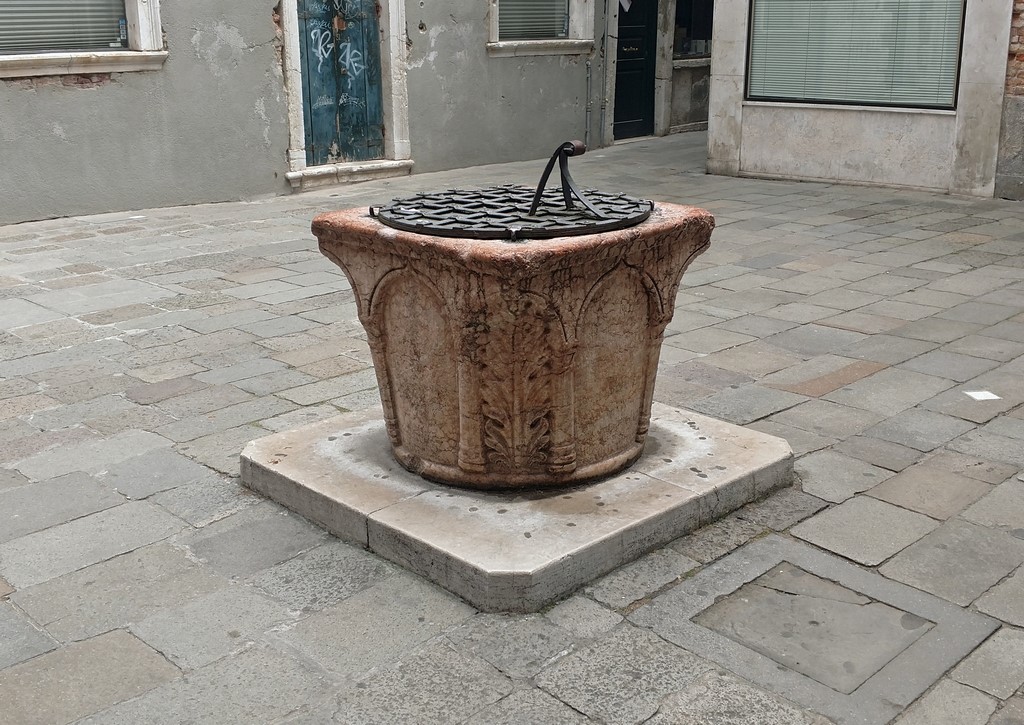Water Everywhere

I had traveled through Italy before, but I’d never been to Venice – and arrived there late in June 2017 with all sorts of expectations and suppositions about what I’d find, especially when it came to water.
The city is a collection of islands in a marshy lagoon, so I presumed it’d be a paradise of fountains. After all, the Venice Republic had a history as a major global power in trade and finance for nearly a thousand years, so I assumed it would rival Rome in the splendor of its water displays.
Clearly, I hadn’t done any research at all in preparation for our trip (I’ve never liked spoiling surprises), but I did know that the city was organized as neighborhoods around campi, the plazas where I figured I’d see fountain after fountain as we moved from museum to museum (and restaurant to restaurant).
 As I discovered, there is indeed water in every one of the campi, but the function was almost invariably utilitarian and the appearance mostly far from dramatic: The fontanas of Venice, I learned, are essentially wellheads designed to make potable water available to the surrounding residences and businesses – no more, no less.
As I discovered, there is indeed water in every one of the campi, but the function was almost invariably utilitarian and the appearance mostly far from dramatic: The fontanas of Venice, I learned, are essentially wellheads designed to make potable water available to the surrounding residences and businesses – no more, no less.
 In all, Venice has nearly 150 of these campi fountains, sometimes more than one if the plaza is large enough. The structures tend to be squat and weather-worn, but it’s clear that when first installed they were well crafted and that there was some pride and maybe even competitiveness in dressing up their functionality.
In all, Venice has nearly 150 of these campi fountains, sometimes more than one if the plaza is large enough. The structures tend to be squat and weather-worn, but it’s clear that when first installed they were well crafted and that there was some pride and maybe even competitiveness in dressing up their functionality.
In many cases, we saw water flowing freely from small spouts, and there were placards in some places that tried to convince wary tourists of the safety of taking a drink. But that’s only about the half of it: The rest of the fontanas are capped and sealed, and my supposition is that in these cases the common public resource has been fully replaced by indoor plumbing systems and municipal water service.
 Although I was disappointed not to find more extroverted water displays, I found myself being increasingly impressed by the immensity of the city’s achievement in civil engineering. After all, the city is located in the midst of a tidal salt marsh, and the task of creating as many as 150 outlets for freshwater in virtually limitless quantities in such a place must have been monumental.
Although I was disappointed not to find more extroverted water displays, I found myself being increasingly impressed by the immensity of the city’s achievement in civil engineering. After all, the city is located in the midst of a tidal salt marsh, and the task of creating as many as 150 outlets for freshwater in virtually limitless quantities in such a place must have been monumental.
 I read an article indicating that water was highly regulated in the city in former times and that the locked wellheads were opened just twice daily for closely timed periods to allow citizens to gather water for domestic or commercial needs. It seems a bit like a system of pre-modern water coolers that would’ve turned the fontanas into social hubs – places to hear news, see neighbors and, in the simple act of waiting, catch a break from daily cares.
I read an article indicating that water was highly regulated in the city in former times and that the locked wellheads were opened just twice daily for closely timed periods to allow citizens to gather water for domestic or commercial needs. It seems a bit like a system of pre-modern water coolers that would’ve turned the fontanas into social hubs – places to hear news, see neighbors and, in the simple act of waiting, catch a break from daily cares.
Digging wells and preventing saltwater incursion in a place like Venice is no small task; structuring the campi to capture and channel rainwater and move it through sand filters to replenish the wells was inspired; and the thought that such a water-supply system served upwards of 100,000 residents for generations is awesome. Quite a place, quite a history – but, alas, few water displays beyond the sloshing of the canals.
Rest assured, however, that the city does have a smallish collection of interesting waterfeatures, a few of which I’ll get to in future Travelogues.










